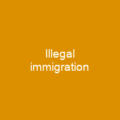Understanding Immigration: A Global Perspective
Immigration is the movement of people to a destination country for permanent residence. This phenomenon has been a cornerstone of human history, shaping societies and economies across the globe. The term ‘immigration’ was coined in the 17th century, referring to non-warlike population movements between emerging nation states. As of 2015, there were 244 million international migrants worldwide, with significant populations residing in the United States, Germany, Russia, Saudi Arabia, the UK, and the UAE.
Push and Pull Factors
The decision to immigrate is often driven by a complex interplay of push and pull factors. Push factors refer primarily to the motive for leaving one’s country of origin (either voluntarily or involuntarily), whereas pull factors refer to one’s motivations behind or the encouragement towards immigrating to a particular country.
Push Factors
Immigrants are motivated to leave their former countries of citizenship for various reasons, including:
- Lack of local access to resources
- Economic prosperity
- Family reunification
- Retaliation or escape from prejudice, conflict, or natural disaster
Pull Factors
On the other hand, pull factors include:
- Economic opportunities
- Political stability and safety
- Cultural attractions
- Education and healthcare access
Economic Impacts of Immigration
The economic effects of immigration suggest benefits to both receiving and sending countries. Research shows that:
- Immigration can boost GDP and reduce poverty in developing countries.
- Low-skill immigration has been linked to greater income inequality in native populations, but overall immigration accounts for a small share of wage inequality growth in developed countries.
- A 2018 study found that allowing people to move from low-productivity places to high-productivity places is the most efficient generalized policy tool for poverty reduction.
Remittances and Fiscal Effects
Remittances totaled $420 billion in 2009, mostly going to developing countries. Studies show that:
- Fiscal effects of immigration vary, but most credible analyses find small and positive fiscal effects on average.
- A 2022 study found that reduced refugee admissions affected US public coffers negatively.
Impact on Native Populations
The relationship between immigration and crime is mixed worldwide. Research shows:
- Reduced crime rates in some cases.
- No significant effect of non-native speakers of English in the UK, immigrant children in Dutch schools, or recent immigrants in Italy.
Healthcare and Social Services
Immigration tends to increase local rents and house prices. However, high immigration can cause stress on highly regulated sectors like healthcare and education. A 2018 study found that immigration reduced waiting times for outpatient referrals in the UK.
Assimilation and Integration
Immigrant assimilation is a complex process:
- First-generation immigrants tend to hold less accepting views of homosexuality but opposition weakens with longer stays.
- Second-generation immigrants are more accepting of homosexuality.
Policy Implications
Immigration policies can lead to net economic gain for host countries but also exacerbate global inequality. Research suggests that migration can have both positive and negative impacts on receiving and sending countries. Studies have found that:
- Larger immigrant population shares can yield positive impacts on institutional quality.
- Selective immigration policies favor wealthy, educated, or skilled workers, often at the expense of poor donor countries.
Human Rights and Discrimination
The treatment of migrants in host countries is a topic of debate and criticism due to human rights violations. Despite being ratified by 48 states, major migrant-receiving countries have not ratified the UN Convention on the Protection of Migrant Workers.
Conclusion
Immigration is a multifaceted issue with profound economic, social, and political implications. While it brings numerous benefits to both sending and receiving countries, challenges such as integration, discrimination, and human rights violations must be addressed. Understanding the complexities of immigration can help policymakers craft more effective and humane policies that benefit all stakeholders.

You want to know more about Immigration?
This page is based on the article Immigration published in Wikipedia (retrieved on March 14, 2025) and was automatically summarized using artificial intelligence.






